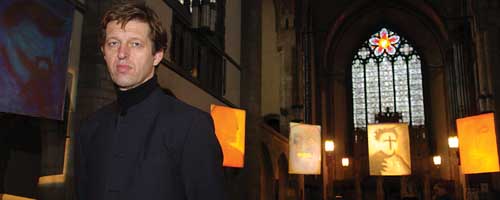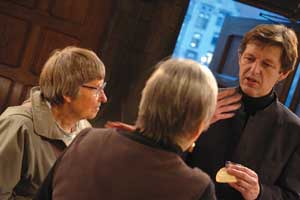Jesus’ earthly companions visit Rockefeller’s nave
By Jennifer CarnigNews Office
 |
Those who enter Rockefeller Memorial Chapel between now and March will have an audience of 13 watching their every move.
“Apostles,” an art exhibition of the 12 apostles and Paul, as interpreted by Swedish artist Michel Östlund, is on display prominently in the chapel’s nave. The icon’s giant faces are impossible to ignore. Each painting is more than six feet tall and four feet wide, and is suspended from the ceiling by nearly transparent wire, so each appears as if it is floating in the neo-gothic space that is Rockefeller Memorial Chapel.
The artist manipulates the chapel’s shadows so darkness envelops each solitary face, but uses stage lighting so each apostle appears as a bright beacon of color, creating an environment perfect for religious reflection.
The viewer is in a black, cavernous space with only the waning winter light entering the chapel’s magnificent stained glass windows and 13 somber portraits of Jesus’ earthly companions hovering in the shadows overhead.
 Swedish artist Michel Östlund discusses his paintings, which are presented in the art exhibition “Apostles,” with two visitors to the show in Rockefeller Memorial Chapel. Östlund’s paintings represent Jesus’ 13 earthly companions, the 12 apostles and Paul. | |
Östlund created each painting based on each apostle’s personality, as described in available literature, but also so each face portrays a different human characteristic. Thomas appears doubtful; Philip, longing; John, loving; Simon, rebellious; and Andrew, seeking.
A single color—rich blue, gold or crimson—dominates each painting, and each face is painted abstractly, many missing eyes, a nose or a mouth. But the abstract nature of the exhibition does not mean “Apostles” is inaccessible—each painting carries with it an unavoidable feeling, be it contemplative or repentant.
The idea for painting the apostles came to Östlund 13 years ago as he was picking up his 83-year-old great aunt from a hospital in Stockholm.
“I had promised to take her on a long ride through the city for the very special reason that she had been blind for six years and had recently, with the help of the medical profession, regained her sight,” writes Östlund in an exhibition companion book. “Naturally, our conversation in the car revolved around what it was like to be able to see again. About how many people there are who never see, even though they can.”
The conversation between Östlund and his great aunt turned to the role of the artist in opening the eyes of the observer and, somehow, to the subject of the apostles. She began to describe the character of each apostle, which the artist began imagining as images in his mind. “Before the trip was over,” Östlund writes, “I had decided to paint the apostles.”
It is a project he returns to again and again—many of the paintings in this exhibition were created as recently as 2002.
“What has fascinated me is that their message is still the basis for many of our values today. Two thousand years later, the challenge has been to use the portraits to open eyes to something I do not see myself,” Östlund writes.
Many of the portraits do not seem to see, either. Most have no eyes, and those that do have closed eyes or hollow ovals, void of pupils. There are no smiles here, either—those apostles with discernable mouths are tight-lipped and silent.
 Judas Iscariot is interpreted by Östlund in the painting above, which hangs from a central focal point in the chapel’s nave. A special musical event, featuring the Rockefeller Chapel Choir, the University Chorus, the Motet Choir and organist Thomas Weisflog, is scheduled to take place Saturday, Feb. 26, 2005. Surrounded by Östlund’s paintings, the choirs will perform Mendelssohn, Edlund and Sandstrom. | |
Though the artist uses a bright color palette, there is undoubtedly a sense of loneliness or sadness present in each oil painting. And yet each portrait also emanates a sense of peace, as if the apostles themselves are waiting for what is to come next or meditating on all that has passed.
“Apostles” is cosponsored by the Swedish American Museum Center where, in conjunction with the Rockefeller presentation, a show of Östlund’s prints and smaller works also are on display. The exhibition, on a world tour with Chicago as its first stop outside of Scandinavia’s cathedrals and churches, will travel next to New York, and then to Europe and New Zealand.
Rockefeller Memorial Chapel is open daily from 8 a.m. to 4 p.m. and will display the “Apostles” show until Thursday, March 31, 2005. Admission is free.
A special event, “In the Glorious Company of the Apostles,” will feature the Rockefeller Chapel Choir, the University Chorus, the Motet Choir and organist Thomas Weisflog at 8 p.m. Saturday, Feb. 26, 2005. This musical presentation will celebrate the exhibition with performances of Mendelssohn’s “Te Deum,” Edlund’s “Gloria” and Sandstrom’s “Agnus Dei.”
Tickets are $15 general and $8 for students and seniors. For more information, visit http://rockefeller.uchicago.edu or call (773) 702-7059.
![[Chronicle]](/images/sidebar_header_oct06.gif)